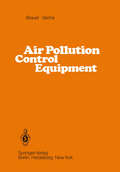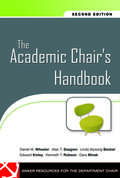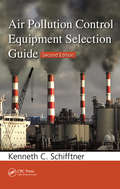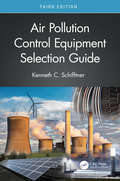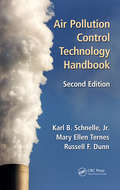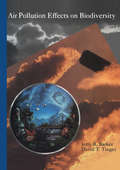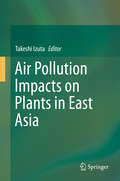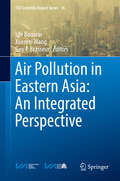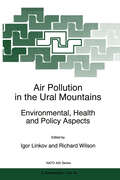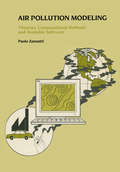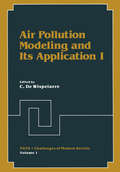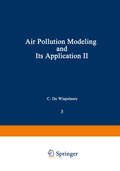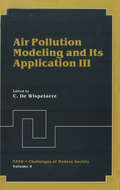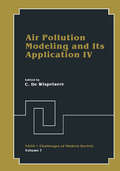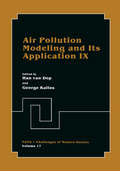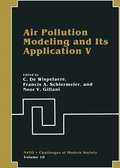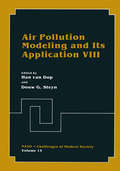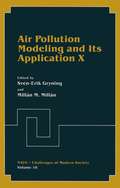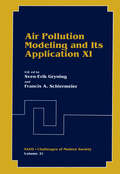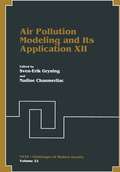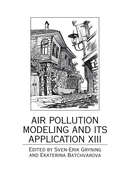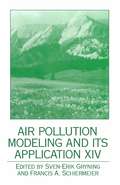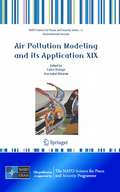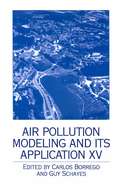- Table View
- List View
Air Pollution Control Equipment
by H. Brauer Y. B. VarmaThis book has arisen directly from a course on Air and Water Pollution Control delivered by the first named author at the Technical University of Berlin. Extractions of this course have been presented in Brazil, Turkey and India. It was at the Indian Institute of Technology of Madras where the first named author got in contact with Professor Varma, who turned out to be a suggestive, cooperative coauthor. This book is addressed primarily to chemical, environmental and mechanical engineers, engaged in the design and operation of equipment for air pollution control. But it will certainly be helpful to chemists and physicists confronted with the solution of environmental problems. Furthermore it is intended as a text book for engineering courses on environmental protection. The goal of the book is the presentation of knowledge on design and operation of equipment applicable to the abatement of harmful emissions into air. The technology of air pollution control is of relatively young age, but it has already achieved a high degree of performance, due to the research and develop ment work invested in the last decades in this field.
Air Pollution Control Equipment Calculations
by Louis TheodoreUnique problem-and-solution approach for quickly mastering a broad range of calculations This book's problem-and-solution approach enables readers to quickly grasp the fundamentals of air pollution control equipment and essential applications. Moreover, the author sets forth solid principles for the design and selection of air pollution control equipment as well as for its efficient operation and maintenance. Readers gain a deep understanding of both the equipment itself and the many factors affecting performance. Following two introductory chapters, the book dedicates four chapters to examining control equipment for gaseous pollutants, including adsorption, absorption, and incineration equipment. The remaining six chapters deal with equipment for managing airborne particulate pollutants, including gravity settlers, cyclones, electrostatic precipitators, scrubbers, and baghouses. The appendix contains discussions of hybrid systems, the SI system (including conversion constants), and a cost-equipment model. Each chapter offers a short introduction to the control device discussed. Next, progressively more difficult problems with accompanying solutions enable readers to build their knowledge as they advance through the chapter. Problems reflect the most recent developments in pollution control and include a variety of performance equations and operation and maintenance calculations. Each problem includes a statement of the problem, the data used to solve the problem, and a detailed solution. Readers may further hone their skills by visiting the text's Web site for additional problems and solutions. This publication serves both as a textbook for engineering students and as a reference for engineers and technicians who need to ensure that air pollution control equipment operates efficiently and enables their facility to meet all air pollution control standards and regulations.
Air Pollution Control Equipment Selection Guide
by Kenneth C. SchifftnerThis book is a good discussion of various air pollution control equipment. It covers a wide range of equipment and gives a good overview of the principles and applications. Very valuable is the practical experiences that are not commonly available in a typical textbook. The language is easy to understand, especially for those who do not have formal
Air Pollution Control Equipment Selection Guide
by Kenneth C. SchifftnerThis new edition of Air Pollution Control Equipment Selection Guide builds upon the successes of previous editions that developed a detailed discussion on various technologies used for air pollution control. This book covers a wide range of equipment and provides a good overview of the related principles and applications. A particularly valuable feature are the practical examples, not commonly available in other books. Based on the author’s fifty years of experience in applying and operating air pollution control equipment, this book provides easy-to-read information on basic air pollution control technology and is the quintessential resource for the busy engineer and for those who do not have formal training in air pollution control.FEATURES OF THE THIRD EDITION Uniform and consistent applications information for comparing the effectiveness of different technologies. Provides answers to questions about how to reduce operating costs and how to achieve peak performance. Concise descriptions of each equipment with diagnostics and testing suggestions. New chapters on optimization techniques that help readers deal with different types of hardware for better performance and efficacy.
Air Pollution Control Equipment Selection Guide
by Kenneth C. SchifftnerThis new edition of Air Pollution Control Equipment Selection Guide builds upon the successes of previous editions that developed a detailed discussion on various technologies used for air pollution control. This book covers a wide range of equipment and provides a good overview of the related principles and applications. A particularly valuable feature are the practical examples, not commonly available in other books. Based on the author’s fifty years of experience in applying and operating air pollution control equipment, this book provides easy-to-read information on basic air pollution control technology and is the quintessential resource for the busy engineer and for those who do not have formal training in air pollution control.FEATURES OF THE THIRD EDITION Uniform and consistent applications information for comparing the effectiveness of different technologies. Provides answers to questions about how to reduce operating costs and how to achieve peak performance. Concise descriptions of each equipment with diagnostics and testing suggestions. New chapters on optimization techniques that help readers deal with different types of hardware for better performance and efficacy.
Air Pollution Control Technology Handbook
by Karl B. Schnelle Jr. Russell F. Dunn Mary Ellen TernesA detailed reference for the practicing engineer, Air Pollution Control Technology Handbook, Second Edition focuses on air pollution control systems and outlines the basic process engineering and cost estimation required for its design. Written by seasoned experts in the field, this book offers a fundamental understanding of the factors resulting i
Air Pollution Effects on Biodiversity
by David T. Tingey Jerry R. BarkerBiodiversity is the delicate ecological balance within biological systems such as species and populations. Evidence suggests air pollution disrupts and impoverishes ecosysytems processes, and genetic and population diversity. Based on a symposium conducted by the EPA's Environmental Research Laboratory, this book pulls together current knowledge on the subject, assesses its relevance, and offers a framework for future research on the impact of air pollution on biodiversity through all levels of biological organization. This text is particularly timely due to acid rain and other toxic problems. The text also discusses the best available control technology, management practices, alternative chemicals, and legislative ways to reduce the impact of air pollution on biodiversity.
Air Pollution Impacts on Plants in East Asia
by Takeshi IzutaThis is the only book to offer an up-to-date overview of air pollution in East Asia and the effects of air pollutants such as ozone, acid deposition and aerosols on Asian crops and trees. It is unique in that it discusses the fundamentals of environmental plant science and research advances in the area at the plant ecophysiology level. It addresses various topics, including gaseous air pollutants such as ozone; soil acidification and atmospheric nitrogen deposition due to acid deposition; PM2.5 and the effects of air pollutants on growth, yield and physiological functions such as photosynthesis of crops and trees in East Asia. It is a valuable resource for environmental scientists, plant scientists, government officials, industrialists, environmentalists, undergraduate and graduate students and anyone interested in the application of the latest findings to agricultural production and protection of forest ecosystems in Asia. It also provides useful information for professionals involved in research, development, production, processing and marketing of agricultural products, including those in developing countries who are interested in advanced environmental science in this field.
Air Pollution in Eastern Asia: An Integrated Perspective (ISSI Scientific Report Series #16)
by Idir Bouarar Xuemei Wang Guy P. BrasseurThis book, written by an international group of experts from China, Europe and the USA, presents a broad and comprehensive analysis of the chemical and meteorological processes responsible for the formation of air pollutants in eastern Asia, and in particular for the development of severe pollution episodes observed primarily during winter in the northeastern part of China. With the rapid population growth, economic development and urbanization occurring in Asia, air pollution has become a major environmental problem in this part of the world. The book is organized around six distinct parts. The first part of the volume offers a general perspective on issues related to air pollution including persistent haze events in eastern and southern Asia. The second part presents an overview of air pollution sources (i.e., anthropogenic and biomass burning sources). The third part analyzes in-situ observations of chemical species in China, while the fourth part focuses on space observations of gas-phase and aerosol species. The modeling aspects are treated in the fifth part of the volume, which includes a presentation of several air quality forecast systems and an assessment of the role of urbanization on air pollution levels. Finally, the effects of air pollution on health and crop productivity in China are discussed in the last part of the book. The book also presents an integrated view of past and present situations in Asia and provides the scientific basis from which mitigation policies can be established and air quality can be improved. Audience: This book is written for scientists, educators, students, environmental managers, policy-makers and leaders in public administration and private corporations who wish to use science-based information to mitigate air pollution. The book should help decision-makers to design effective policies for air quality improvement and to successfully manage short-term air pollution episodes that substantially affect people’s quality of life and strongly impact the economy.
Air Pollution in the Ural Mountains: Environmental, Health and Policy Aspects (NATO Science Partnership Subseries: 2 #40)
by Igor Linkov R. WilsonMankind has created pollution, and has suffered its consequences since time immemorial. This has intesified greatly since the industrial revolution. One of the main problems in society, and a major function of government is how to cope with this pollution. 80 years ago the maxim used to be "the solution to pollution is dilution"; to dilute any pollted water supply in a large river, or to build a tall chimney stack to dilute air pollutants into the air so that concentrations of pollutants are always low. Since 1950 western countries have gone further and made major attempts to reduce the emissions of the most important pollutants. The discussion of what is an important pollutant has changed. To S02 and heavy metals such as cadmium or arsenic we now add fine particles and even (when we discuss global climate change) C02. The experience and practice of the western countries was only partly followed in the USSR (although the switch from use of coal to natural gas in major cities around 1970 was very important). Since the collapse of the USSR it has become fashionable both in the west and inside Russia to blame all society's ills on pollution. The statistics do not bear out that conclusion, but pollution remains an important issue which can be reduced without significant detriment to other societal values.
Air Pollution Modeling: Theories, Computational Methods and Available Software
by Paolo ZannettiFinishing this book is giving me a mixture of relief, satisfaction and frus tration. Relief, for the completion of a project that has taken too many of my evenings and weekends and that, in the last several months, has become almost an obsession. Satisfaction, for the optimistic feeling that this book, in spite of its many shortcomings and imbalances, will be of some help to the air pollution scientific community. Frustration, for the impossibility of incorporating newly available material that would require another major review of several key chap ters - an effort that is currently beyond my energies but not beyond my desires. The first canovaccio of this book came out in 1980 when I was invited by Computational Mechanics in the United Kingdom to give my first Air Pollution Modeling course. The course material, in the form of transparencies, expanded, year after year, thus providing a growing working basis. In 1985, the ECC Joint Research Center in Ispra, Italy, asked me to prepare a critical survey of mathe matical models of atmospheric pollution, transport and deposition. This support gave me the opportunity to prepare a sort of "first draft" of the book, which I expanded in the following years.
Air Pollution Modeling and Its Application I (Nato Challenges of Modern Society #1)
by C. WispelaereThis is the first in a new series of publications arlslng out of the work of the Committee on Challenges of Modern Society of the North Atlantic Treaty Organization. The CCMS was established in 1969 with a mandate to examine practical ways of improving the exchange of experience among mem ber nations of the Alliance in the task of creating a better envir onment for their societies. It was charged with considering "spe cific problems of the human environment with the deliberate objec tive of stimulating action by member governments". It may come as a surprise to some that NATO - generally thought of as being an organization devoted solely to matters of defence - should concern itself with the environment at all. But this is to overlook Article 2 of the North Atlantic Treaty of 1949, which expressly provides that member count ries should contribute towards the furt her development of peaceful and friendly internat ional relations by promoting conditions of stability and well being. This concern is reflected in many non-military areas, in addition to the environmental one. I wish the present volume, which has been edited by the Bel gian Prime Minister's Office for Science Policy Programming, every success.
Air Pollution Modeling and Its Application II (Nato Challenges of Modern Society #3)
by C. De WispelaereIn 1969 the North Atlantic Treaty Organization established the Committee on the Challenges of Hodern Society. Air Pollution was from the start one of the priority problems under study within the framework of the pilot studies undertaken by this Committee. The organization of a yearly symposium dealing with air pollution modeling and its application is one of the main activities within the pilot study in relation to air pollution. After being organized for five years by the United States and for five years by the Federal Republic of Germany, Belgium, repre sented by the Prime Minister's Office for Science Policy Programming, became responsible in 1980 for the organization of this symposium. This volume contains the papers presented at the 12th Interna tional Technical Meeting on Air Pollution Modeling and its Appli cation held at SRI International, Menlo Park, California in the USA from 25th to 28th August 1981. The meeting was jointly organized by the Prime Minister's Office for Science Policy Programming, Belgium and SRI International, USA. The conference was attended by 109 participants and 51 papers have been presented. The members of the selection committee of the 12th I.T.M. were A. Berger (Chair man, Belgium), W. Klug (Federal Republic of Germany), L.E. Niemeyer (United States of America), L. Santomauro (Italy), J. Tikvart (United States of America), M.L. Williams (United Kingdom), H. Van Dop (The Netherlands), C. De Wispelaere (Coordinator, Belgium).
Air Pollution Modeling and Its Application III (Nato Challenges of Modern Society #5)
by C. De WispelaereIn 1969 the North Atlantic Treaty Organization established the Committee on the Challenges of Modern Society. Air Pollution was from the start one of the pri9rity problems under study within the framework of the pilot studies undertaken by this Committee. The organization of a yearly symposium dealing with air pollution modeling and its application is one of the main activities within the pilot study in relation to air pollution. After being organized for five years by the United States and for five years by the Federal Republic of Germany, Belgium, represented by the Prime Minister's Office for Science Policy Programming, became responsible in 1980 for the organization of this symposium. This volume contains the papers presented at the 13th Inter national Technical Meeting on Air Pollution Modeling and its Appli cation held at lIe des Embiez, France, from 14th to 17th September 1982. This meeting was jointly organized by the Prime Minister's Office for Science Policy Programming, Belgium, and the Ministere de l'Environnement, France. The conference was attended by 120 participants and 45 papers have been presented. The closing ses sion of the 13th I. T. M. has been attended by Mr. Alain Bombard, French Minister of the Environment. The members of the selection committee of the 13th I. T. M. were A. Berger (Chairman, Belgium), W. K1ug (Federal Republic of Germany), K. Demerjian (United States of America), L. Santomauro (Italy), M. L. Williams (United Kingdom), H. Van Dop (The Netherlands), H. E. Turner (Canada), C.
Air Pollution Modeling and Its Application IV (Nato Challenges of Modern Society #7)
by C. De WisepelacreIn 1969 the North Atlantic Treaty Organization established the Committee on the Challenges of Modern Society. Air Pollution was from the start one of the priority problems under study within the framework of the pilot studies undertaken by this Committee. The organization of a yearly symposium dealing with air pollution modeling and its application is one of the main activities within the pilot study in relation to air pollution. After being organized for five years by the United States and for five years by the Federal Republic of Germany, Belgium, represented by the Prime Minister's Office for science Policy, became responsible in 1980 for the organization of this symposium. This volume contains the papers presented at the 14th Inter national Technical Meeting on Air Pollution Modeling and its Appli cation held in Copenhagen, Denmark, from 27th to 30th September 1983. This meeting was jointly organized by the Prime Minister's Office for Science Policy, Belgium, and the National Agency of Environmental Protection, Air Pollution Laboratory, Ris~ National Laboratory, Denmark. The conference was attended by 103 partici pants and 43 papers have been presented. The members of the se lection committee of the 14th I.T.M. were A. Berger (Chairman, Belgium), W. Klug (Federal Republic of Germany), K. Demerjian (United States of America), L. Santomauro (Italy), R. Van Dop (The Netherlands), R.E. Turner (Canada), C. De Wispelaere (Coordinator, Belgium).
Air Pollution Modeling and Its Application IX (Nato Challenges of Modern Society #17)
by H. Van Dop George KallosThe interest in air pollution modelling has shown substantial growth over the last five years. This was particularly evident by the increasing number of participants attending the NATO/CCMS International Technical Meetings on Air Pollution modelling and its Application. At the last meeting 118 papers and posters were selected from an abundance of submitted abstracts divided over five modelling topics: (i) model assessment and verification, including policy applications, (ii) air pollution modelling in coastal areas with emphasis on the mediterranean region, (iii) accidental atmospheric releases, including warning systems and regulations, (iv) modelling of global and long-range transport and (v) new developments in turbulent diffusion. A round-table discussion chaired by John Irwin (USA) and Jan Kretzschmar (Belgium) on the harmonization of air pollution models was attended by more than 50 scientists and is reported in these proceedings. The opening paper addressed the main issue of this conference: modelling over complex terrain. Of particular interest were coastal areas where the surface inhomogeneities introduce small-scale circulation and varying atmospheric stability, often combined with a complex topography. As the conference was located on the beautiful island of Crete, problems faced by the host nation, particularly Athens and its environs were obvious examples for consideration. These together with other regions with similar geographical features were addressed. Heavily populated and industrialized as they often are, air quality is generally poor there and emission regulations are desired. Obviously, a major task of air pollution dispersion modelling is to assist policy makers in formulating sensible regulations.
Air Pollution Modeling and Its Application V (Nato Challenges of Modern Society #10)
by Frank A. Schiermeier Noor V. GillaniIn 1969 the North Atlantic Treaty Organization (NATO) established the Committee on Challenges of Modern Society (CCMS). The subject of air pollution was from the start one of the priority problems under study within the framework of various pilot studies undertaken by this Committee. The organization of a yearly conference dealing with air pollution modeling and its application has become one of the main activities within the pilot study relating to air pollution. The international conference was organized for the first five years by the United States and for the second five years by the Federal Republic of Germany. Belgium, represented by the Prime Minister's Office for Science policy, became responsible in 1980 for organizing the third five years of the annual conference. This volume contains the papers presented at the 15th NATO/CCMS International Technical Meeting (ITM) on Air Pollution Modeling and Its Application, held in St. Louis, Missouri, from the 15th to 19th April 1985. This ITM was jointly organized by the Prime Minister's Office for Science Policy, Belgium (Pilot Country); by the Environmental Protection Agency, Atmospheric Sciences Research Laboratory, United States (Host Country); and by Washington University, Mechanical Engineering Department (Host Organization).
Air Pollution Modeling and Its Application VIII (Nato Challenges of Modern Society #15)
by H. Van Dop Douw G. SteynIn 1949, when the North Atlantic Treaty was ratified, one of its articles explicitly noted '1hat member countries should contribute towards the further development of peaceful and friendly international relations." Specific problems related to the human environment were addressed by the Committee of Challenges of Modern Society (CCMS) of NATO, established in 1969. This provided a framework within which a series of International Technical Meetings (ITMs) on Air Pollution Modelling has been held. This volume documents the proceedings of the 18th meeting in this series. Science, like the arts and sports, provides an ideal vehicle for "developing peaceful and friendly international relations". National boundaries have never been barriers to the movement of air pollution, and fortunately this has also proved true of scientists studying the transport of air pollution. It is thus satisfying to record that since the mid-seventies it has been commonplace to find Eastern European scientists among attendees at the ITMs which have (in a very modest way) participated in a precursor to the process which has led to historical changes in Europe and which will undoubtedly lead to a tremendous increase in personal and intellectual exchange on a worldwide basis.
Air Pollution Modeling and Its Application X (Nato Challenges of Modern Society #18)
by Sven-Erik Gryning Millán M. MillánThe 20th International Technical Meeting on Air Pollution Modelling and Its Application was held in Valencia, Spain, during late 1993. At this conference, a new record of abstracts was submitted, a new record of scientists participated, and a new record of countries was represented. This clearly indicates society's continuous and growing interest in, as well as importance of, the complexities associated with the modelling of air pollution. The conference addressed the following main subjects: integrated regional modelling, global and long-range transport, new modelling developments, accidental releases, and model assess ment and verification. In addition, two project-oriented workshops were organized as part of the conference. The many contributing authors and scientists taking active part in the discussions following the papers, have made this proceeding a record of the current status in the field of air pollu tion modelling. We want to express our gratitude to their efforts. We also wish to extend our gratitude to the sponsors that made this conference possible. In addition to financial support from NATOjCCMS the conference received contributions from CEAM, the European Asso ciation for the Science of Air Pollution, Danish Center for Air Research, and Ris0 National Laboratory. A special grant was given by NATOjCCMS to facilitate attendance of scientists from Central and Eastern Europe. We also wish to express our gratitude to Rosa Salvador and Pilar Zamora of CEAM, who laboriously organized the conference pre-proceedings, and to Anne N0rregaard and Ulla Riis Christiansen of Ris0 National Laboratory, who seved as conference secretariat.
Air Pollution Modeling and Its Application XI (Nato Challenges of Modern Society #21)
by Sven-Erik Gryning Francis A. SchiermeierProceedings of the Twenty-first NATO CCMS International Technical Meeting held in Baltimore, Maryland, November 6-10, 1995
Air Pollution Modeling and Its Application XII (Nato Challenges of Modern Society #22)
by Sven-Erik Gryning Nadine ChaumerliacProceedings of the Twenty-Second NATO/CCMS International Technical Meeting held in Clermont-Ferrand, France, June 2-6, 1997
Air Pollution Modeling and Its Application XIII
by Sven-Erik Gryning Ekaterina BatchvarovaThe ITM conference series has always had a strong spirit of cooperation under the NATO/CCMS umbrella, and with the considerable interest fram Partner countries to participate in the ITM conferences, it provides an excellent opportunity to create ties between scientists. Whereas all previous ITM conferences have taken place in NATO countries, the 23rd ITM takes place in a Cooperative Partner country, Bulgaria, and is hosted by the National Institute of Meteorology and Hydrology, Bulgarian Academy of Sciences. This fact reflects a general wish for a closer connection and collaboration among scientists fram Partner and NATO countries. This volume contains the papers from the 23rd NATO/CCMS International Technical Meetings on Air Pollution Modelling and Its Application, being held September 28 - October 2, 1998, at Riviera Holiday Club, Varna, Bulgaria. It was attended by 120 participants from 30 countries. Thanks are due to all who made it possible to plan, carry through, and follow up the meeting, and to the participants who made the conference so successful. Special thanks are due to the sponsoring institutions: ATO/CCMS EURASAP RIS0 BAS 3M NATO/CCMS - Committee on the Challenges of Modem Society EURASAP - European Association for the Science of Air Pollution RIS0 - Ris0 National Laboratory, Denmark NIMH - National Institute of Meteorology and Hydralogy, Bulgaria BAS - Bulgarian Academy of Sciences 3M Representation office, Bulgaria Prestige Business Ltd. , Bulgaria The excellent collaboration with CIM (Company for International Meetings Ltd.
Air Pollution Modeling and its Application XIV
by Sven-Erik Gryning Francis A. SchiermeierProceedings of the Millennium NATO/CCMS International Technical Meeting on Air Pollution Modeling and its Application, held May 15-19 in Boulder, Colorado. This volume is the latest in a series of proceedings dating back to 1971. The book addresses the problem of air pollution and reports the latest findings and developments in air pollution modeling, from a truly international list of contributors.
Air Pollution Modeling and Its Application XIX (NATO Science for Peace and Security Series C: Environmental Security)
by Carlos Borrego Ana Isabel MirandaIn 1969, the North Atlantic Treaty Organization (NATO) established the C- mittee on Challenges of Modern Society (CCMS). The subject of air pollution was from the start one of the priority problems under study within the framework of various pilot studies undertaken by this committee. The organization of a periodic conference dealing with air pollution modelling and its application has become one of the main activities within the pilot study relating to air pollution. The first five international conferences were organized by the United States as the pilot country, the second five by the Federal Republic of Germany, the third five by Belgium, the fourth four by The Netherlands, the next five by Denmark and the last five by Portugal. This volume contains the abstracts of papers and posters presented at the 29th NATO/CCMS International Technical Meeting on Air Pollution Modelling and Its Application, held in Aveiro, Portugal, during September 24–28, 2007. This ITM was organized by the University of Aveiro, Portugal (Pilot Country and Host Organization). The key topics distinguished at this ITM included: Local and urban scale modelling; Regional and intercontinental modelling; Data assimilation and air quality forecasting; Model assessment and verification; Aerosols in the atmosphere; Interactions between climate change and air quality; Air quality and human health.
Air Pollution Modeling and its Application XV
by Carlos Borrego Guy SchayesIn 1969 the North Atlantic Treaty Organization (NATO) established the Committee on Challenges of Modern Society (CCMS). The subject of air pollution was from the start, one of the priority problems under study within the framework of various pilot studies undertaken by this committee. The organization of a periodic conference dealing with air pollution modelling and its application has become one of the main activities within the pilot study relating to air pollution. These international conferences were successively organized by the United States (first five); Federal Republic of Germany (five); Belgium (five); The Netherlands (four) and Denmark (five). With this one Portugal takes over the duty. This volume contains the papers and poster abstracts presented at the NATO/CCMS International Technical Meeting on Air Pollution Modelling and Its Application held in Louvain-la-Neuve, Belgium, during 15-19 October 2001. This ITM was jointly organized by the University of Aveiro, Portugal (Pilot country) and by the Catholic University of Louvain, Belgium (host country). The ITM was attended by 78 participants representing 26 countries from Western and Eastern Europe, North and South America, Asia, Australia and Africa. The main topics of this ITM were : Role of Atmospheric Models in Air Pollution Policy and Abatement Strategies; Integrated Regional Modelling; Global and Long-Range Transport; Regional Air Pollution and Climate; New Developments; and Model Assessment and Verification.
